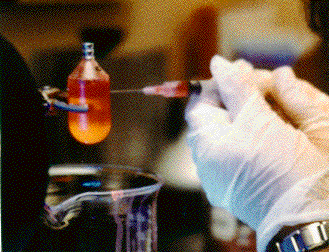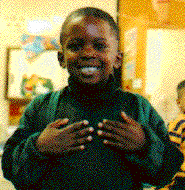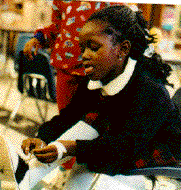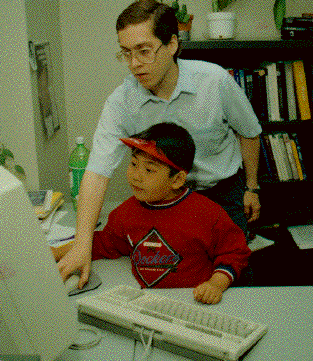
Educational Tools for Teachers
- Science Kits
- STC / K-12 Collaboration on Developing Educational Tools
- Use of STC Equipment by K-12 Teachers
- Computer Resources for K-12 Teachers
Classroom science activities offer many opportunities for learning. The challenge for teachers, however, is to present the material in an interesting way while ensuring that the students have mastered the concepts. Through joint projects between STC staff and teachers, more than one approach is developed for educational programs and tools that are interesting and useful.
 Techniques of gene manipulation taught in
the Center for Microbial Ecology's (CME's) Environmental Gene Probe
Workshop are an integral part of CME's research technology;
biotechnology basics are included in the CME's K-12 program.
Techniques of gene manipulation taught in
the Center for Microbial Ecology's (CME's) Environmental Gene Probe
Workshop are an integral part of CME's research technology;
biotechnology basics are included in the CME's K-12 program.
Science Kits
Several centers have developed teaching "modules" that teachers can easily adapt into their curricula. The Center for Microbial Ecology (CME), for example, has developed Hands-On the Environment, a manual of in-class activities for biology teachers. Available in both English and Spanish, the manual enables an instructor to teach concepts in microbiology on a modest budget. Many of the materials can be obtained at grocery or hardware stores. To date, the manual has been requested by educators in several states and Puerto Rico. In 1993, CME conducted 11 on-site teacher training workshops at inner-city and rural high schools that used the manual.Another type of hands-on project for teachers is being developed by the Center for Quantized Electronic Structures (QUEST). QUESTBOARDS are self-contained electrical circuit boards that can easily fit on a tabletop. The 13 different circuit boards can be used by students and teachers to demonstrate ideas in circuit theory, electromagnetism, and solid-state technology. This effort has been successful in attracting more than 1,500 students because of student interest in these boards and because of the instructional material and training that the teachers receive as support from the center. Half of the students who have used these kits are underrepresented minorities.
As with all programs involving collaborations with teachers, STC efforts in developing science kits reach a significant number of students. The Center for Molecular Biotechnology sponsors a one-week "Teacher Institute" that, by the end of the 1994-95 school year, will impact about 15,000 students in the greater Los Angeles area. In this program, participants learn laboratory techniques to take back to their classes such a DNA fingerprinting and polymerase chain reaction. In addition to the hands-on laboratory experience, the program includes lectures by Caltech and University of Washington faculty on the Human Genome Project, the immune system, and molecular genetics. One past teacher-participant noted of these lectures that "the researchers made me feel like an equal.I could ask any question and get an understandable and sincere answer from them." Teachers attending the institute also have access to fully equipped kits for student experiments, which include detailed laboratory protocols and teachers' guides. More than 80% of the students served by this program are underrepresented minorities.
The Geometry Center has supported curriculum projects for use in middle school and high school classrooms. Following each summer course, a team of teacher participants is selected to continue with further research and to write curriculum modules appropriate for grade 7-12 students. The modules parallel the topic of the course and make portions of the course more accessible to precollege students. Modules are currently available in curvature, fractals, and computer graphics.
In addition to working with schools, STCs also work with other organizations to develop hands-on science modules. The Center for the Analysis and Prediction of Storms is working with the Omniplex Science Museum in Oklahoma City to develop weather kits for classroom use. The kit will include 28 activities with instruments that include a rain gauge, wind meter, wind vane, anemometer, aneroid barometer, sling psychrometer, globe, water cycle poster, cloud types slides, a copy of the USA Today Weather Book, and a class set of student thermometers. Each kit also will contain a teacher's guide with instructions for students to build their own instruments and information on the use of the weather instruments included in the kit, the roles of the sun and geography in weather, air pressure and its effects, simple forecasting, and how clouds and precipitation form.
Other STCs have adopted similar approaches to involving organizations outside of K-12 schools. The Center for Clouds, Chemistry, and Climate collaborate with education staff at the Stephen-Birch Aquarium-Museum to develop the "Discovery Kits" and the "TravelLab." The lab can either be loaned to the teachers or it can be duplicated by using readily available materials. Kits include biology, geology, chemistry, meteorology, and physics material all intended to assist the teaching of global climate change. Also, the Promega Corporation worked with the Center for Biological Timing to develop a biotechnology kit for high schools and colleges. The kit is well suited for students unfamiliar with biotechnology and, like "Hands-On the Environment," costs for the experiments are kept at a minimum.

 Researchers at the
Center for Research in Cognitive Science participate in "Constructing
Science: Materials and Activities for Kindergarten and First Grade,"
which is part of a colloquium series for K-1 teachers that develops
and field tests six new science units. Collaborators include
elementary school teachers, center staff, and specialists in science
education and cognitive psychology.
Researchers at the
Center for Research in Cognitive Science participate in "Constructing
Science: Materials and Activities for Kindergarten and First Grade,"
which is part of a colloquium series for K-1 teachers that develops
and field tests six new science units. Collaborators include
elementary school teachers, center staff, and specialists in science
education and cognitive psychology.
STC / K-12 Collaboration on Developing Educational Tools
Flexibility remains a key feature of several curriculum development initiatives. In many instances, teachers have worked with STC staff to create customized curricular material. For example, the Center for Advanced Liquid Crystalline Optical Materials (ALCOM) is working with secondary school teachers across the country who are testing an ALCOM instructional science kit. The teachers are providing ALCOM with input on how the kit can present optics and liquid crystals in a manner easily comprehended by K-12 students. The kits are sent out with the ALCOM Educational Outreach newsletter. More than 500 schools have asked to participate, and students in one school even manufacture devices for these kits as part of their manufacturing curriculum.Since 1991, the Center for Advanced Cement-Based Materials has participated in the summer "Materials Technology Workshop" for high school science teachers, a program organized by the Department of Materials Science and Engineering at the University of Illinois. In 1993, support from the NSF allowed 40 high school teachers and 20 faculty participants from the university to develop modules for use in high school science courses. Modules developed include several specific material science topics and a computer-based Hypercard module that presents an overview of all the materials. One teacher, Lloyd Hasty from Murray High School, Murray, Kentucky, said that it was the "best NSF workshop I have attended during the past 27 years." A set of 10-15 modules will be published and distributed to science teachers nationwide.
Use of STC Equipment by K-12 Teachers
When performing in-class experiments, high school teachers can use an STC's up-to-date equipment, which is often financially out of reach for most school districts. The Center for Superconductivity's "instructional van" brings equipment, demonstrations, and other materials to schools in the Chicago and Urbana areas to help perform in-class experiments on the synthesis, characterization, and application of high-temperature superconductors. Center workshops give teachers the resources and materials to provide students with hands-on experience in simple cryogenic techniques.The use of center equipment for demonstrations has been an effective supplement for other types of high school science classes. The Center for High Pressure Research brings scientific equipment to earth science classes at secondary schools in Long Island, New York. Center staff bring scale models of functioning equipment, three-dimensional molecular models of mineral crystal structures, and interactive computer software, all of which is integrated into class lessons.
 Computer Resources for K-12 Teachers
Computer Resources for K-12 Teachers
Several STCs use computer networks to develop curricular material with
K-12 teachers. At the Center for Light Microscope Imaging and
Biotechnology (CLMIB), center staff work with Pittsburgh-area high
school science teachers to adapt the center's raw research results
into a multimedia format that their students can understand. In
another CLMIB program, teachers learned to use the Internet computer
network and then compiled potential curricular materials into a CLMIB
library on the Internet. In conjunction with departments at Kent State
University, the Center for Advanced Liquid Crystalline Optical
Materials also uses the Internet to distribute science and mathematics
instructional material to secondary schools. Through SAM-NET, schools
can also access these materials as well as encyclopedias,
dictionaries, mathematics and chemistry tables, handbooks, and indexes
to journal articles.
Centers also distribute computer software that presents science in an interactive, multimedia environment. The Center for Engineering Plants for Resistance Against Pathogens has effectively used computers to teach science to students in an exciting way. "One of the attractions [of this program] is that students can learn at their own pace," said Stephen McGloughlin, one of the center researchers who developed a program called "GERM WARS." The program contains text, cartoons, graphics, and animation that discuss the many aspects of how people, animals, and plants defend themselves against disease-causing microbes. The software is currently being evaluated as part of the curricula for high school science teachers in central California.
The Center for Computer Graphics and Scientific Visualization brings the excitment of computer graphics to elementary and middle school visitors. Children can preform for digital video or watch their image change into a friend's image using a "morphing" tool.
K-12 Education
Sites & Affiliations | Leadership | Research & Applications | Major Accomplishments | FAQ | Search | Knowledge & Technology Transfer | Calendar of Events | Education & Outreach | Media Resources | Technical Reports & Publications | Parallel Computing Research Quarterly Newsletter | News Archives | Contact Information
| Hipersoft | CRPC |
© 2003 Rice University
|